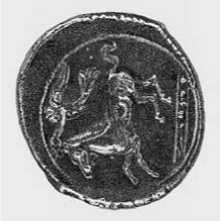LANGUAGE
The Carthaginians spoke a dialect referred to as Punic, or Pun. It was related to Phoenician, the Semitic language of Carthage’s founders, but influenced by Berber, the Hamitic language of the Berbers of North Africa.
HISTORY
The colony of Carthage evolved into a city-state under an aristocracy of nobles and wealthy merchants. Through conquest and trade it became influential throughout the Mediterranean region. By the sixth century B. C.E. Carthaginians had subjugated the Libyan tribes and earlier Phoenician colonies and controlled the coast of North Africa from the western extent of Egypt to the Atlantic Ocean.
Carthaginian Activity in Europe
The Carthaginians, following the earlier Phoenician tradition, were a seagoing people and were active in commerce in the Mediterranean region. In the sixth century B. C.E. Carthage gained control of Malta and Sardinia (part of present-day Italy), which had formerly been Phoenician and then Greek colonies.
The Carthaginians had trade contacts beyond the Mediterranean region, however, reached by sailing through the Strait of Gibraltar into the Atlantic Ocean. In about 450 B. C.E. Himilco, perhaps the brother of Hanno, who had earlier explored part of Africa’s west coast, visited Atlantic coastal areas to the north, as far as present-day Brittany in France and the British Isles, although there is no archaeological evidence to indicate such travels. It is thought they used this route to trade for tin.
Starting in 409 B. C.E. the Carthaginians waged war with the Greeks over Sicily, gaining a foothold in the west; the eastern boundary of Carthaginian power was the Halycus (modern Platani) River. Yet attempts to control the entire island led to a series of defeats over the centuries.
In the third century B. C.E. the Romans challenged Carthage’s control of the western Mediterranean in a series of three wars known as the Punic Wars (after the Roman name for the Phoenicians, Poeni). In 241 B. C.E. at the end of the First Punic War (264-241 B. C.E.) the Carthaginian general Hamilcar Barca was forced to make peace with the Romans, after a naval defeat by the Roman consul Gaius Lutatius Catulus, and to give up holdings in Sicily.
In 237 B. C.E. Hamilcar Barca led an invasion of the Iberian Peninsula, fighting Iberians and Celtiberians. His son-in-law, Hasdrubal, and his son, Hannibal, completed the conquest, occupying present-day southeastern Spain. Hasdrubal founded the city of Carthago Nova (New Carthage; modern Cartagena) in 227 B. C.E.
In the Second Punic War (218-201 B. C.E.) Hannibal, with a full baggage train and elephants, marched eastward along the Mediterranean’s north coast from Spain and crossed the Alps in a journey into Italy, where he had success against Roman forces. The Carthaginian victory in the Battle of Cannae in 216 B. C.E. was one of the worst defeats in Roman history. The city of Rome held against his forces, however, and Roman victories elsewhere led to Hannibal’s recall to Africa in 203 B. C.E. In 202 B. C.E. at Zama, northwest of Carthage, he was defeated by a Roman army under Scipio Africanus (Scipio the Elder), which led to loss of territory in Spain.
The End of Carthage
In 146 B. C.E. at the end of the Third Punic War (149-146 B. C.E.), the Romans under Scipio Aemilianus Africanus Numantinus (Scipio the Younger) sacked and burned Carthage. A new city, founded by the Romans in 29 B. C.E., became a center of Roman administration. The
Germanic Vandals under Gaiseric, along with the SUEBI and Alans, invaded Africa from Spain and in 439 c. e. occupied Carthage, making it their capital. In 533 c. e. it was taken by the BYZANTINES. In the late seventh century C. E. with Arab expansion westward, Carthage again came under attack and was destroyed in 698. The site, under Arab control, was continuously inhabited over the centuries and is presently a suburb of Tunis.
CULTURE (see also Phoenicians) Carthage, as a center of trade, became a melting pot of people and ideas, especially influenced by Greece and Egypt.
Economy
The Carthaginian economy was built around trade. Among the Carthaginian products were purple dye, African grain, fruits, nuts, wine,


Carthaginians used coins such as this one from the late fifth century b. c.e. (Drawing by Patti Erway)
Slaves, exotic animals, ivory, lumber, pottery, glassware, jewelry, beds, and bedding. They bartered these goods for tin, silver, and gold.
Carthage was ruled by a king, a council of elders known as the Gerousia, and two suffetes, or magistrates. The suffetes held office on the basis of merit and wielded much of the power. The wealthy merchant families also had a great deal of influence.
The Carthaginians controlled the shipping lanes, protecting their monopoly through a powerful navy Some of their galley ships were quadriremes and quinqueremes, with four or five tiers of oars on each side, designed for ramming ships. They also used foreign mercenaries, especially Iberians, Celtiberians, and GAULS, They minted gold coins to pay for their armies.
Baal-hammon (Amon), the chief deity, and Tanit (Tinith), probably his consort, and the equivalent of the Phoenician goddess Astarte, thought to represent the Sun and the Moon, respectively, were worshipped by the Carthaginians, along with other minor gods. Baal-hammon and Tanit supposedly fertilized the soil and provided renewal. Versions of the Greek gods Demeter and Persephone and the Roman goddess Juno also were worshipped by Carthaginians.
The Carthaginians, as did other Phoenicians, carried on the tradition of far-reaching sea travel and commerce. Carthaginian merchants were so common in foreign lands that they were even satirized in Greek theater. In competition with the militaristic Romans, however, the Carthaginians also concerned themselves with conquest and, maintaining a presence in Europe for part of their history, becoming an early obstacle to Roman expansion. The historic struggle with the Carthaginians further fueled the Roman trajectory toward empire.
Further Reading_
Brian Caven. The Punic Wars (New York: St. Martin’s, 1980).
Leonard Cottrell. Hannibal: Enemy of Rome
(Cambridge, Mass.: Da Capo, 1992).
Nathan Davis. Carthage and Her Remains (New York: Hyperion, 1985).
Thomas Alan Dorey. Rome against Carthage (London: Seeker & Warburg, 1971).
Adrian Goldsworthy. The Fall of Carthage: The Punic Wars 265-146 b. c.e. (London: Cassel Wellington, 2004).
Serge Lancel and Antonia Nevill. Carthage: A History (Oxford: Blackwell, 1994).
John Pedley, ed. New Light on Ancient Carthage (Ann Arbor: University of Michigan Press, 1980).
Adolf Schulten. The Carthaginians in Spain, vol. 7 (Cambridge: Cambridge Ancient History, 1923).
Brian Herbert Warmington. Carthage (New York: Praeger, 1969).




 World History
World History









